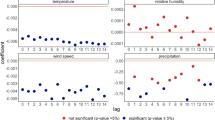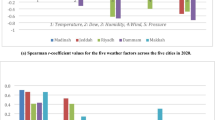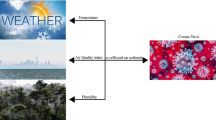Abstract
Several conspiracy theories and hypotheses have been postulated by some individuals from various strata of governance globally concerning the outbreak and spread of the novel coronavirus in the last quarter of 2019. A pertinent hypothesis is the correlation of meteorological elements to the spread of the pandemic. To verify this claim and also confirm the initial findings of Tosepu et al.’s (2020), this study investigated the Spearman rank-order correlation of the number of confirmed COVID-19 cases in the Russian Federation with temperature—maximum, minimum, and average as well as precipitation. Our findings indicated a stronger correlation between average temperature (rs = 0.75***) and also recorded significant correlations for the other variants of temperature. Hence, the hypothesis of weather-induced COVID-19 spread is substantiated.
Similar content being viewed by others
Avoid common mistakes on your manuscript.
Introduction
The first pneumonia cases with unknown etiology were first discovered in Wuhan, China in early December 2019 (Guan et al. 2020). This outbreak elicited intense cautionary notice not only within China but across the world. The Chinese health specialists carried out an urgent investigation to typify and rheostat the disease; this includes isolating suspected diseased individuals, meticulous monitoring of people that have been in contact with the affected individuals, clinical and epidemiological data collection, and spawning diagnostic and treatment procedures (Wang et al. 2020). According to Li et al. (2020), until early January 2020, the government of China declared the pneumonia was coronavirus or COVID-19, and the World Health Organization has declared the disease a pandemic of international concern (Sohrabi et al. 2020).
The first coronavirus case and death case in Russia was discovered in Moscow on March 2 and 19, 2020 (The New York Times 2020), and as of June 12, 2020, the confirmed cases have increased to 511,423 (The Moscow Times 2020). Six provinces with the highest number of coronavirus cases are Moscow (202,935), Moscow Oblast (47,911), Saint Petersburg (20,043), Nizhny Novgorod Oblast (13,562), Sverdlovsk Oblast (8826), and Rostov Oblast (7152) (Statista 2020). The rise in the cases occurred rapidly and has since spread across the Federation (see Fig. 1).
There has been growing interest in the relationship between climate variables and respiratory virus spread. According to Baker et al. (2019), the respiratory syncytial virus (RSV) is dependent on humidity and shows a correlation with climate (Pitzer et al. 2015). Both RSV and influenza increases epidemics and transmission in low humidity and peaks during the winter period; however, enteroviruses mostly peak in the summer period (Martinez 2018). With respect to the transmission of COVID-19 and meteorological conditions, several studies have been conducted in different countries such as Iran (Ahmadi et al. 2020), China (Ma et al. 2020; Liu et al. 2020), the USA (Bashir et al. 2020). The inferences with respect to the nexus between COVID-19 spread and meteorological conditions have remained controversial.
While there have been several studies establishing the relationships between meteorological factors and COVID-19, none, to our knowledge has been carried out with respect to the Russian Federation. Therefore, our study expects to offer new substantiation by examining the relationship between different climatic factors such as precipitation (PREP) and temperature (maximum temperature, T-MAX; minimum temperature, T-MIN; and average temperature (T-AVG) with the novel coronavirus (COVID-19 in the Russian Federation).
Methods
The current study employed data from the Russian Federation. The Russian Federation is considered as the largest in the world with over 17 million square kilometers in area and pancontinental which is situated in Northern Asia and Eastern Europe with 47 provinces and over 144 million population with an annual growth rate of − 0.013% as at 2018 (The World Bank 2020). The data set for weather between March 21 and May 28, 2020 were obtained from National Oceanic and Atmospheric Administration (NOAA), while the daily COVID-19 data were obtained from Statista for the same period. Also the data of amount of precipitation (mm), average temperature (°C), minimum temperature (°C), and maximum temperature (°C) were also sourced from NOAA (see Table 1).
As shown in Table 2, the data collected for the study were not normally distributed as skewness and kurtosis values of amount of precipitation were above the threshold absolute values of 2 and 10 respectively. Given this realization, Spearman’s rank-order correlation which take into account the monotonic function among variables was considered appropriate for the analysis of our data (Sahin 2020). The Spearman’s correlation coeficient (rs) can be derived using the following formulae:
where di implies the difference between the ranks of two parameters and n is the number of alternatives.
Furthermore, Johansen’s (1992) cointegration analysis was performed to determine the robustness of the variables of concern.
Result and discussion
This study was designed to verify the weather-induced COVID-19 spread hypothesis that suggests a significant correlation between the number of confirmed cases and weather elements such as temperature, humidity, precipitation, and rainfall. In this study, daily temperature—maximum, minimum, and average and volume of precipitation were correlated with the total number of confirmed cases using Spearman rank-order correlation. This method is preferred based on the evidence from descriptive statistics as documented in Table 2 shows that our data are non-normally distributed. As reported in Table 3, our findings indicated that all three forms of temperature significantly correlated with the number of cases in the federation. Specifically, the average daily temperature correlates the most with the number of cases (rs = 0.75, p < .001). This finding resonated with empirical conclusions of scholars (such as Sahin 2020; Tosepu et al. 2020) who both established that average temperature as a meteorological element that contributes significantly to the spread of COVID-19 in Turkey and Indonesia respectively. Unlike these studies, our result indicated a stronger average temperature correlation coefficient than Sahin (2020) at r = 0.483, and Tosepu et al. (2020) at r = 0.392.
In addition, our result indicated higher significant correlation for minimum temperature (rs = 0.72, p < .001) than for maximum temperature (rs = 0.57, p < .001). This suggests that on the day of confirmed cases, changing temperature is also attributable to the incidence of the cases. In other words, with a degree of Celcius reduction in temperature, there is an approximately 72% increase in the number of cases. This finding is in line with those of Gupta et al. (2020), which posited that variation in humidity and temperature affected the spread of COVID-19 in the USA. In a state-specific study of New York, Bashir et al. (2020) also elicited similar findings for the correlation between the minimum and maximum temperature. Their result indicated that the COVID-19 case is only significantly correlated with minimum temperature and not maximum temperature, thus, suggesting that with every degree reduction in temperature will see some percentage increase in the number of cases. Besides, the finding equally buttresses the argument of (Sahin 2020), which concluded that the COVID-19 spread is reduced with increasing value of temperature. However, precipitation does not significantly contribute to the spread of the novel virus. This result mirrors that of Tosepu et al. (2020) that found in the case of Jakarta, that neither humidity nor rainfall significantly correlated to the number of cases.
Understanding the behavior of this novel viral infection is crucial as it will not only help in the fight to overcome its spread but also provide a valuable contribution to human-environment interactions that may be essential in the preservation of our natural resources. As pointed out by Zambrano-Monserrate et al. (2020), COVID-19 has both negative and positive indirect effects on the environment. Specifically, they highlighted the possible detrimental impact of waste disposal due to the rampaging spread of the virus as well as its contribution to the reduction of the emission of greenhouse gases. While the study clearly articulated both sides of the effect of the pandemic, they are also specific in stating that the long-run negative effect may outweigh the positives. Given these arguments, our environment is at greater risk of environmental problems should we linger in dealing with the spread of the pandemic. In addition, the result from Johansen cointegration test showed that there are at most two cointegration vectors among the series of COVID-19, T-Min, T-Max, T-AVG, and precipitation as evidenced in Table 4 given in the appendix.
To summarize, this study validated the weather-induced COVID-19 spread hypothesis by confirming the significant correlation of all variants of temperature with the number of confirmed cases in the Russian Federation. Also, this finding supports those of extant literature, thereby validating the same hypothesis across various countries as this study added Russia to the growing list of countries (Indonesia, Turkey, and the USA) where empirical studies have been used to confirm the hypothesis.
This study included 69 observations of daily records from March 21 to May 28, 2020. While this range represents a critical period in the lifespan of COVID-19 cases in the Russian Federation, it is also a tiny cross-section of time in which the novel pandemic has been ravaging. Hence, the result of the study should be interpreted in lieu of this noted limitation. The exploratory nature of the current study also offers a future research avenue as the examination of other factors such as governmental policy directions towards containing the spread may be insightful.
Conclusion
In the ongoing global fight against the spread of COVID-19 pandemic, this study as well as several other scholarly works have validated the weather-induced COVID-19 spread hypothesis as true. That is, climate change and climatic conditions such as daily minimum temperature, daily maximum temperature, and daily average temperature among other elements are essential in minimizing the spread of the infectious disease.
Data availability
The datasets used and/or analyzed during the current study are available from the corresponding author on reasonable request.
References
Ahmadi M, Sharifi A, Dorosti S, Ghoushchi SJ, Ghanbari N (2020) Investigation of effective climatology parameters on COVID-19 outbreak in Iran. Sci Total Environ 138705
Baker RE, Mahmud AS, Wagner CE, Yang W, Pitzer VE, Viboud C et al (2019) Epidemic dynamics of respiratory syncytial virus in current and future climates. Nat Commun 10(1):1–8
Bashir MF, Ma B, Komal B, Bashir MA, Tan D, Bashir M, others (2020) Correlation between climate indicators and COVID-19 pandemic in New York, USA. Sci Total Environ 138835
Guan W, Ni Z, Hu Y, Liang W, Ou C, He J, Liu L, Shan H, Lei CL, Hui DSC, du B, Li LJ, Zeng G, Yuen KY, Chen RC, Tang CL, Wang T, Chen PY, Xiang J, Li SY, Wang JL, Liang ZJ, Peng YX, Wei L, Liu Y, Hu YH, Peng P, Wang JM, Liu JY, Chen Z, Li G, Zheng ZJ, Qiu SQ, Luo J, Ye CJ, Zhu SY, Zhong NS, China Medical Treatment Expert Group for Covid-19, others (2020) Clinical characteristics of coronavirus disease 2019 in China. N Engl J Med 382(18):1708–1720
Gupta S, Raghuwanshi GS, Chanda A (2020) Effect of weather on COVID-19 spread in the US: a prediction model for India in 2020. Sci Total Environ 138860
Johansen S (1992) Cointegration in partial systems and the efficiency of single-equation analysis. J Econ 52(3):389–402
Li Q, Guan X, Wu P, Wang X, Zhou L, Tong Y, Ren R, Leung KSM, Lau EHY, Wong JY, Xing X, Xiang N, Wu Y, Li C, Chen Q, Li D, Liu T, Zhao J, Liu M, Tu W, Chen C, Jin L, Yang R, Wang Q, Zhou S, Wang R, Liu H, Luo Y, Liu Y, Shao G, Li H, Tao Z, Yang Y, Deng Z, Liu B, Ma Z, Zhang Y, Shi G, Lam TTY, Wu JT, Gao GF, Cowling BJ, Yang B, Leung GM, Feng Z, others (2020) Early transmission dynamics in Wuhan, China, of novel coronavirus--infected pneumonia. N Engl J Med 382:1199–1207
Liu J, Zhou J, Yao J, Zhang X, Li L, Xu X et al (2020) Impact of meteorological factors on the COVID-19 transmission: a multi-city study in China. Sci Total Environ 138513
Ma Y, Zhao Y, Liu J, He X, Wang B, Fu S et al (2020) Effects of temperature variation and humidity on the death of COVID-19 in Wuhan, China. Sci Total Environ 138226
MacKinnon JG, Haug AA, & Michelis L (1999) Numerical distribution functions of likelihood ratio tests for cointegration. J Appl Econom 14(5):563-577
Martinez ME (2018) The calendar of epidemics: seasonal cycles of infectious diseases. PLoS Pathog 14(11):e1007327
National Oceanic and Atmospheric Administration (2020) Climate data online: dataset discovery. Retrieved June 11, 2020, from National Centers for Environmental Information website: https://www.ncdc.noaa.gov/cdo-web/datasets#GHCND
Pitzer VE, Viboud C, Alonso WJ, Wilcox T, Metcalf CJ, Steiner CA, Haynes AK, Grenfell BT (2015) Environmental drivers of the spatiotemporal dynamics of respiratory syncytial virus in the United States. PLoS Pathog 11(1):e1004591
Sahin M (2020) Impact of weather on COVID-19 pandemic in Turkey. Sci Total Environ 138810
Sohrabi C, Alsafi Z, O’Neill N, Khan M, Kerwan A, Al-Jabir A et al (2020) World Health Organization declares global emergency: a review of the 2019 novel coronavirus (COVID-19). Int J Surg
Statista (2020) Coronavirus (COVID-19) confirmed cases in Russia. Retrieved June 12, 2020, from Statista website: https://www.statista.com/statistics/1102935/coronavirus-cases-by-region-in-russia/
The Moscow Times (2020) Russia’s coronavirus cases continue steady Rrise Past 500 K as country emerges from lockdown. Retrieved June 13, 2020, from The Moscow Times website: https://www.themoscowtimes.com/2020/06/12/russias-coronavirus-cases-continue-steady-rise-as-country-emerges-from-lockdown-a69710
The New York Times (2020) A coronavirus mystery explained: Moscow has 1,700 extra death. Retrieved June 12, 2020, from The New York Times website: https://www.nytimes.com/2020/05/11/world/europe/coronavirus-deaths-moscow.html
The World Bank (2020) Population, total- Russian Federation. Retrieved June 11, 2020, from https://data.worldbank.org/indicator/SP.POP.TOTL?locations = RU
Tosepu R, Gunawan J, Effendy DS, Lestari H, Bahar H, Asfian P, others (2020) Correlation between weather and Covid-19 pandemic in Jakarta, Indonesia. Sci Total Environ 138436
Wang C, Horby PW, Hayden FG, Gao GF (2020) A novel coronavirus outbreak of global health concern. Lancet 395(10223):470–473
Zambrano-Monserrate MA, Ruano MA, Sanchez-Alcalde L (2020) Indirect effects of COVID-19 on the environment. Sci Total Environ 138813
Acknowledgments
We thank anonymous reviewers.
Author information
Authors and Affiliations
Contributions
KKE worked on the methodology section, discussion, and conclusion. TT contributed in the introduction section of the manuscript and literature section.
Corresponding author
Ethics declarations
Competing interests
The authors declare that they have no competing interests.
Additional information
Responsible Editor: Lotfi Aleya
Publisher’s note
Springer Nature remains neutral with regard to jurisdictional claims in published maps and institutional affiliations.
Appendix
Appendix
Rights and permissions
About this article
Cite this article
Lasisi, T.T., Eluwole, K.K. Is the weather-induced COVID-19 spread hypothesis a myth or reality? Evidence from the Russian Federation. Environ Sci Pollut Res 28, 4840–4844 (2021). https://doi.org/10.1007/s11356-020-10808-x
Received:
Accepted:
Published:
Issue Date:
DOI: https://doi.org/10.1007/s11356-020-10808-x





